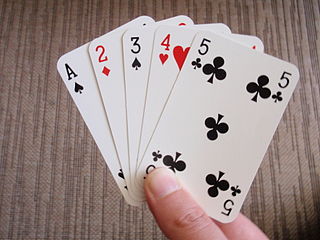 W
WA playing card is a piece of specially prepared card stock, heavy paper, thin cardboard, plastic-coated paper, cotton-paper blend, or thin plastic that is marked with distinguishing motifs. Often the front (face) and back of each card has a finish to make handling easier. They are most commonly used for playing card games, and are also used in magic tricks, cardistry, card throwing, and card houses; cards may also be collected. Some patterns of Tarot playing card are also used for divination, although bespoke cards for this use are more common. Playing cards are typically palm-sized for convenient handling, and usually are sold together in a set as a deck of cards or pack of cards.
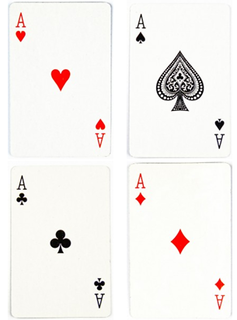 W
WAn ace is a playing card, die or domino with a single pip. In the standard French deck, an ace has a single suit symbol located in the middle of the card, sometimes large and decorated, especially in the case of the ace of spades. This embellishment on the ace of spades started when King James VI of Scotland and I of England required an insignia of the printing house to be printed on the ace of spades. This insignia was necessary for identifying the printing house and stamping it as having paid the new stamp tax. Although this requirement was abolished in 1960, the tradition has been kept by many card makers. In other countries the stamp and embellishments are usually found on ace cards; clubs in France, diamonds in Russia, and hearts in Genoa because they have the most blank space.
 W
WThe ace of hearts (A♥) is a card in a deck of playing cards: the ace in the suit of hearts (♥). There is one ace of hearts in a standard deck of 52 cards.
 W
WThe Ace of Spades is traditionally the highest and most valued card in the deck of playing cards in English-speaking countries. The actual value of the card varies from game to game.
 W
WThe archaeology awareness playing cards are a set of playing cards developed by the United States Department of Defense designed to educate members of the United States military serving in Iraq and Afghanistan about the importance of respecting ancient monuments, to try to preserve the Iraqi and Afghan national cultural heritage. The goal of the publication of the cards was two-fold according to Fort Drum archaeologist Laurie Rush - to prevent unnecessary damage to ancient sites and to stem the illegal trade of artifacts in Iraq. The military has long recognized that educational playing cards are a good way to capitalize on the time soldiers spend waiting for orders.
 W
WThe Banner is a playing card used in Swiss-suited cards and which historically formed part of the standard 36- or 48-card German-suited packs. It is equivalent to a 10, being ranked between a 9 and an Unter.
 W
WIn trick-taking card games such as bridge, the beer card is a name informally given to the seven of diamonds. Players may agree that if a player wins the last trick of a hand with the 7♦, their partner must buy them a beer. This is not considered as part of the rules of these games, but is an optional and informal side-bet between players. This practice likely originates from Danish Tarok or Skat in the middle of the 20th century.
 W
WA blank is a playing card in card-point games that is a non-counter, or is worth nothing. In Poker, the term refers to a community card which is extremely unlikely to help any remaining player.
 W
WCard marking is the process of altering playing cards in a method only apparent to marker or conspirator, such as by bending or adding visible marks to a card. This allows different methods for card sharps to cheat or may be used for magic tricks. To be effective, the distinguishing mark or marks must be visible on the obverse sides of the cards, which are normally uniform.
 W
WCard money is a type of fiat money printed on plain cardboard or playing cards, which was used at times as currency in several colonies and countries from the 17th century to the early 19th century. Where introduced, it was often followed by high rates of inflation.
 W
WCard Sharks is an American television game show created by Chester Feldman for Mark Goodson-Bill Todman Productions. Based on the card game Acey Deucey, the game has two contestants compete for control of a row of oversized playing cards by answering questions posed by the host and then guessing if the next card is higher or lower in value than the previous one. The title Card Sharks is a play on the term "card sharp", a person skilled at card games.
 W
WCartomancy is fortune-telling or divination using a deck of cards. Forms of cartomancy appeared soon after playing cards were first introduced into Europe in the 14th century. Practitioners of cartomancy are generally known as cartomancers, card readers, or simply readers.
 W
WThe Cary Collection of Playing Cards, held at the Beinecke Rare Book & Manuscript Library of Yale University in the United States, is one of the most significant assemblages of materials relating to playing cards and related ephemera in North America.
 W
WPlaying cards were most likely invented in China during the Southern Song dynasty (1127–1279). They were certainly in existence by the Mongol Yuan dynasty (1271-1368). Chinese use the word pái (牌), meaning "plaque", to refer to both playing cards and tiles. Many early sources are ambiguous, and do not specifically refer to paper pái (cards) or bone pái (tiles). In terms of game play, however, there is no difference; both serve to hide one face from the other players with identical backs. Card games are examples of imperfect information games as opposed to Chess or Go.
 W
WThe Curse of Scotland is a nickname used for the nine of diamonds playing card. The expression has been used at least since the early 18th century, and many putative explanations have been given for the origin of this nickname for the card.
 W
WThe Deuce is the playing card with the highest value in German card games. It may have derived its name from dice games in which the face of the die with two pips is also called a Daus in German.
 W
WIn a deck of playing cards, the term face card (US) or court card is generally used to describe a card that depicts a person as opposed to the pip cards. They are also known as picture cards, or until the early 20th century, coat cards.
 W
WA four-color deck (US) or four-colour pack (UK) is identical to the standard French deck except for the color of the suits. In a typical English four-color deck, hearts are red and spades are black as usual, but clubs are green and diamonds are blue. However, other color combinations have been used over the centuries, in other areas or for certain games.
 W
WJohann Kaspar Hechtel was a German businessman, owner of a brass factory in Nuremberg, non-fiction writer and designer of parlour games including the prototype for the Petit Lenormand cartomancy deck. According to published biographies, Hechtel also contributed anonymously to some treatises on physics.
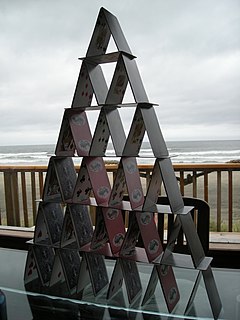 W
WA house of cards is a structure created by stacking playing cards on top of each other, often in the shape of a pyramid. "House of cards" is also an expression that dates back to 1645 meaning a structure or argument built on a shaky foundation or one that will collapse if a necessary element is removed. Structures built by layering in this way, such as Stonehenge, are referred to as "house of cards architecture", which dates back to the Cyclopean and Megalithic ages. The origin of the phrase is debated to be from the 18th century England but some believe that it has an American base.
 W
WA jack or knave, in some games referred to as a bower, is a playing card which, in traditional French and English decks, pictures a man in the traditional or historic aristocratic or courtier dress, generally associated with Europe of the 16th or 17th century. The usual rank of a jack is between the ten and the queen. As the lowest face card, the jack often represents a minimum standard — for example, many poker games require a minimum hand of a pair of jacks in order to open wagering.
 W
WJack's Luck Runs Out is a full-color one-shot comic book created by Jason Little. The book features playing cards as characters, where the title character is a jack. In March 1998, Little received a grant to help publish the book from the Xeric Foundation. The book was published by Top Shelf Productions.
 W
WJerry's Nugget Casino was founded in 1964 by Jerry Lodge and Jerry Stamis in Las Vegas, Nevada. In 1970, the casino printed a special deck of cards that weren't used in their casino, but were sold in their gift shop for fifty cents each. These decks have become highly desired by collectors due to their unique handling qualities, and almost fifty years later they now fetch upwards of $200–500 per deck on the second-hand market.
 W
WThe Joker is a playing card found in most modern French-suited card decks, as an addition to the standard four suits. From the second half of the 20th century, they have also been found in Spanish- and Italian-suited decks, excluding stripped decks. The Joker originated in the United States during the Civil War, and was created as a trump card for the game of Euchre. It has since been adopted into many other card games, where it often acts as a wild card, but may have other functions such as the top trump, a skip card, the lowest-ranking card, the highest-value card or a card of a different value from the rest of the pack. By contrast, a wild card is any card that may be used to represent another card or cards; it need not be a Joker.
 W
WKabufuda (株札) are Japanese playing cards used for gambling games such as Oicho-Kabu.
 W
WThe king is a playing card with a picture of a king displayed on it. The king is usually the highest-ranking face card. In the French version of playing cards and tarot decks, the king immediately outranks the queen. In Italian and Spanish playing cards, the king immediately outranks the knight. In German and Swiss playing cards, the king immediately outranks the Ober. In some games, the king is the highest-ranked card; in others, the ace is higher. Aces began outranking kings around 1500 with Trappola being the earliest known game in which the aces were highest in all four suits. In the Ace-Ten family of games such as pinochle and schnapsen, both the ace and the 10 rank higher than the king.
 W
WThe king is a playing card with a picture of a king displayed on it. The king is usually the highest-ranking face card. In the French version of playing cards and tarot decks, the king immediately outranks the queen. In Italian and Spanish playing cards, the king immediately outranks the knight. In German and Swiss playing cards, the king immediately outranks the Ober. In some games, the king is the highest-ranked card; in others, the ace is higher. Aces began outranking kings around 1500 with Trappola being the earliest known game in which the aces were highest in all four suits. In the Ace-Ten family of games such as pinochle and schnapsen, both the ace and the 10 rank higher than the king.
 W
WThe King of Hearts is a character from the 1865 book Alice's Adventures in Wonderland by Lewis Carroll. He is the husband of the Queen of Hearts.
 W
WThe Knave of Hearts is a character from the 1865 book Alice's Adventures in Wonderland by Lewis Carroll.
 W
WDuring the 2003 invasion of Iraq by a United States-led coalition, the U.S. Defense Intelligence Agency developed a set of playing cards to help troops identify the most-wanted members of President Saddam Hussein's government, mostly high-ranking members of the Iraqi Regional Branch of the Arab Socialist Ba'ath Party or members of the Revolutionary Command Council; among them were some of Hussein's family members. The cards were officially named the "personality identification playing cards". As of 2021, all but 4 of the 52 most wanted have been either killed or captured, eleven of whom have been released.
 W
WThe Ober, formerly Obermann, in Austrian also called the Manderl, is the court card in the German and Swiss styles of playing cards that corresponds in rank to the Queen in French decks. The name Ober is an abbreviation of the former name for these cards, Obermann, which meant something like 'superior' or 'lord'. Van der Linde argues that the King, Ober and Unter in a pack of German cards represented the military ranks of general, officer (Oberofficier) and sergeant (Unterofficier), while the pip cards represented the common soldier.
 W
WA one-way deck is a deck of playing cards where the back of the cards has a pattern that can be oriented to have a "top" and "bottom". Magicians and card sharps can use the orientations of cards in one-way decks to encode information that allows them to perform card tricks.
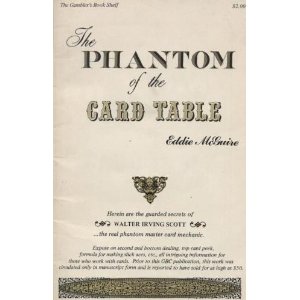 W
WThe Phantom of the Card Table is a manuscript published in 1931 by Eddie McGuire on the card skills and techniques of Walter Irving Scott aka 'The Phantom'.
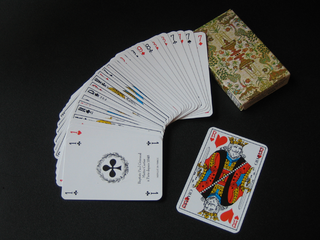 W
WA Piquet pack or, less commonly, a Piquet deck, is a pack of 32 French suited cards that is used for a wide range of card games. The name derives from the game of Piquet which was commonly played in Britain and Europe until the 20th century.
 W
WPlaying Cards, is an 1896 French black-and-white silent actuality film by Georges Méliès. It was the first film in Méliès' prolific career, and thus is number one in his Star Film catalogue. It is a remake of Louis Lumière's film The Messers. Lumière at Cards, which was released earlier the same year. Along with Georges Méliès himself, his brother Gaston Méliès and daughter Georgette Méliès both appear in the film.
 W
WThe queen is a playing card with a picture of a queen on it. In many European languages, the king and queen begin with the same letter so the latter is often called dame (lady) or variations thereof. In French playing cards, the usual rank of a queen is between the king and the jack. In tarot decks, it outranks the knight which in turn outranks the jack. In the Spanish deck and some Italian decks, the Queen does not exist and the Knight appears in them instead, with the same role and value.
 W
WThe queen is a playing card with a picture of a queen on it. In many European languages, the king and queen begin with the same letter so the latter is often called dame (lady) or variations thereof. In French playing cards, the usual rank of a queen is between the king and the jack. In tarot decks, it outranks the knight which in turn outranks the jack. In the Spanish deck and some Italian decks, the Queen does not exist and the Knight appears in them instead, with the same role and value.
 W
WRussian playing cards are cards that were used predominantly in Russia and in the former Soviet Union. Unlike the internationally known standard French 52-card deck, most Russian card games employ either the 36 card or the 32 card decks.
 W
WA dealing shoe or dealer's shoe is a gaming device, mainly used in casinos, to hold multiple decks of playing cards. The shoe allows for more games to be played by reducing the time between shuffles and less chance of dealer cheating. In some games, such as blackjack, using multiple decks of cards can increase the house edge.
 W
WA spoke card, or spokecard, is a card placed in the spokes of a bicycle wheel. They lie parallel to the entire wheel. Most spoke cards are laminated.
 W
WThe standard 52-card deck of French-suited playing cards is the most common pack of playing cards used today. In English-speaking countries it is the only traditional pack used for playing cards; in many countries of the world, however, it is used alongside other traditional, often older, standard packs with different suit symbols and pack sizes. The most common pattern worldwide and the only pattern commonly available in Britain and America is the English pattern pack. The second most common is the Belgian-Genoese pattern, designed in France, but whose use spread to Spain, Italy, the Ottoman Empire, the Balkans and much of North Africa and the Middle East. In addition to those, there are other major international and regional patterns.
 W
WIn playing cards, a suit is one of the categories into which the cards of a deck are divided. Most often, each card bears one of several pips (symbols) showing to which suit it belongs; the suit may alternatively or additionally be indicated by the color printed on the card. The rank for each card is determined by the number of pips on it, except on face cards. Ranking indicates which cards within a suit are better, higher or more valuable than others, whereas there is no order between the suits unless defined in the rules of a specific card game. In a single deck, there is exactly one card of any given rank in any given suit. A deck may include special cards that belong to no suit, often called jokers.
 W
WA talon in card games is a stack of undealt cards that is placed on the table to be used during the actual game. Depending on the game or region, they may also be referred to as the blind, kitty, skat, stock, tapp or widow.
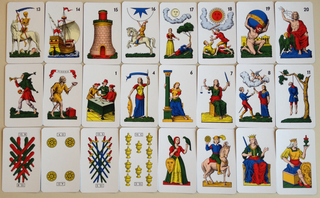 W
WThe Tarocco Siciliano is a tarot deck found in Sicily and is used to play Sicilian tarocchi. It is one of the three traditional Latin-suited tarot decks still used for games in Italy, the others being the more prevalent Tarocco Piemontese and the Tarocco Bolognese. The deck was heavily influenced by the Tarocco Bolognese and the Minchiate. It is also the only surviving tarot deck to use the Portuguese variation of the Latin suits of cups, coins, swords, and clubs which died out in the late 19th and early 20th centuries.
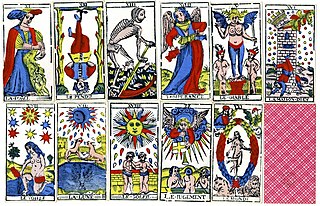 W
WThe tarot is a pack of playing cards, used from at least the mid-15th century in various parts of Europe to play games such as Italian tarocchini, French tarot and Austrian Königrufen, many of which are still played today. In the late 18th century, some tarot decks began to be used for divination via tarot card reading and cartomancy leading to custom decks developed for such occult purposes.
 W
WA transformation playing card is a type of playing card where an artist incorporates the pips of the non-face cards into an artistic design. In a classical transformation playing card, the pips retain their standard position and coloration on the card. In some variations, the pips may be different in size, location or color. There is some debate as to whether these cards, often referred to as semi-transformed, should be considered true transformation playing cards.
 W
WTrionfi are 15th-century Italian playing cards with allegorical content related to those used in tarocchi games. The general English expression "trump card" and the German "trumpfen" have developed from the Italian "Trionfi". Most cards feature the personification of a place or abstraction.
 W
WTujeon are the traditional playing cards of Korea used in the latter half of the Joseon dynasty. They are also known as tupae.
 W
WThe Unter, formerly Untermann, nicknamed the Wenzel, Wenz or Bauer, and also called the Under, is the court card in German and Swiss-suited playing cards that corresponds to the Jack in French decks. The name Unter is an abbreviation of the former name for these cards, Untermann, which meant something like 'subordinate' or 'vassal'. Van der Linde argues that the King, Ober and Unter in a pack of German cards represented the military ranks of general, officer (Oberofficier) and sergeant (Unterofficier), while the pip cards represented the common soldier.
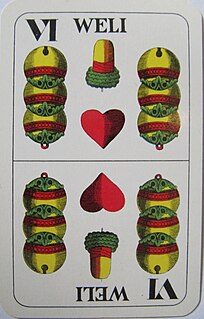 W
WThe Weli, formerly Welli, is a playing card used in the Salzburg and William Tell card decks, which are Austrian regional patterns of the German-suited playing cards. It has the value of 6 of Bells and, in the South Tyrol variant of the card game, Watten, it is the only 6 used and can, in addition to its own suit of Bells, join the trump suits of Acorns, Hearts and Leaves. In all other variants of Watten, the 7 of Bells is the Weli.